How Can Astronomers Overcome The Damage Being Done By Satellite Mega-Constellations?
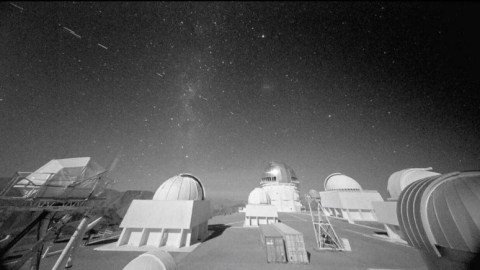
Over the coming decades, over 100,000 new satellites are expected.
For countless millennia, whenever we were faced with a clear, cloudless, moonless night, all of humanity was able to witness the full beauty of a dark, pristine sky. From any location on Earth, thousands of stars could be seen at once, as well as intricate features in the Milky Way, a handful of other galaxies, and even a number of nebulae, star clusters, and other deep sky objects. With the advent of the telescope — and later, photographic techniques and equipment — those numbers exploded. Our views of the distant Universe were limited only by our technology and the investments we made in them.
But two developments have come along to change that. The first was electric lighting, which led to cities, towns, and now even rural areas frequently emitting more light from the ground than everything in the sky combined. As it stands today, only a small percentage of Earth’s population can see more than a few hundred stars with the naked eye over the course of the night. But the second development — artificial satellites — is extremely recent, only affecting the night sky since the dawn of the space age. At the start of 2019, there were approximately 2,000 active satellites; by the end of the decade, that number is anticipated to rise to over 100,000. This will not only forever change the science of astronomy, but humanity’s relationship with space. Over the past few weeks, both the American Astronomical Society and the European Astronomical Society held their summer meetings, where many scientists and industry insiders shared the latest news and challenges at the intersection of satellites and astronomy. Here’s what everyone should know.
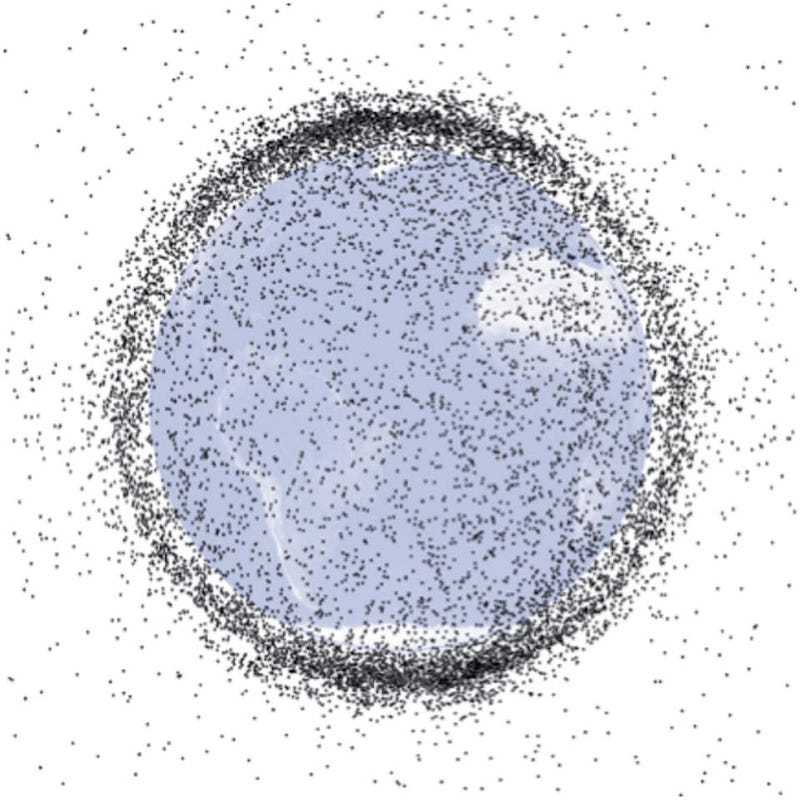
Space is a big place, but low-Earth orbit is not. As soon as we venture beyond Earth’s atmosphere, we find that we’re no longer confined to the small volume just slightly above Earth’s surface, but can occupy whatever location in three-dimensional space that we like.
Above a few hundred kilometers, orbiting satellites can remain stable for months, years, decades, or longer, depending on how they’re outfitted. The farther away you go, the more of Earth you can cover at once, but being closer has its advantages. The closer you are:
- the faster you move,
- you can transmit and receive more data,
- and the lower the latency (i.e., the smaller the lag) between when you send the signal and receive a response.
The downsides, however, are that low-Earth orbit is already full of active and inactive satellites, as well as most of our space debris. The closer you are to Earth, the more satellites you need to obtain global coverage. And, in particular, the more satellites you put up in the narrow volume of space between ~300 km and ~600 km above Earth’s surface — the lowest of low-Earth orbits — the greater the risk of collisions between satellites, and the higher the potential for a single collision to create a chain reaction of collisions between them.
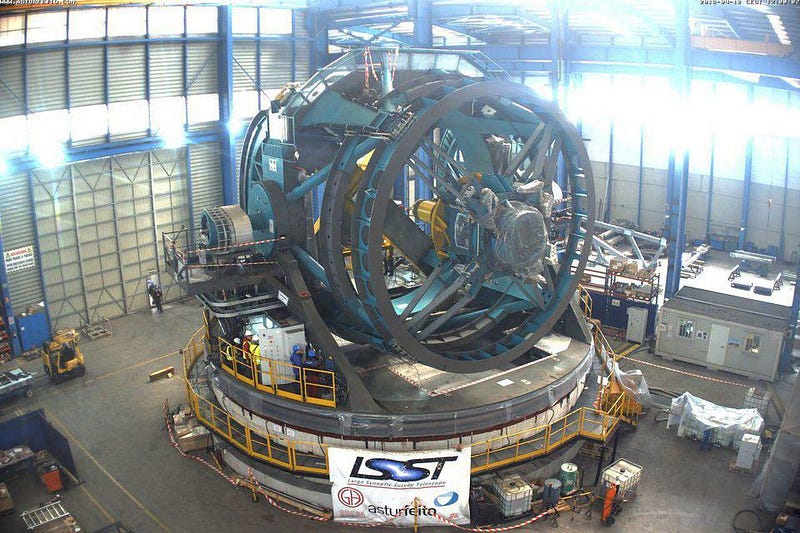
Astronomy prior to 2019. Although light pollution and satellites both have affected astronomy, we have long had moderately successful mitigations to deal with them. Our cutting edge ground-based telescopes have primarily been built — at least in the past half-century — in locations with protected dark skies and with the support of local communities. Space-based telescopes are largely immune to the effects of terrestrial light pollution, while the occasional satellite, whether faint or bright, would only temporarily affect fewer than 1% of the images taken, even with large, wide-field telescopes.
Part of how astronomers would mitigate the effects of satellites was through tracking programs. Because of how well humanity understand the laws of gravity and the effects of Earth’s exosphere on satellite decay — as well as how thoroughly and accurately we’re tracking the objects up there — astronomers could plan their observations, over the course of each night, to minimize the interference of satellites with the collection of valuable science data. With only a few thousand satellites, even including the inactive ones and the large pieces of space debris, the combination of these various interventions allowed astronomers to minimize their losses.
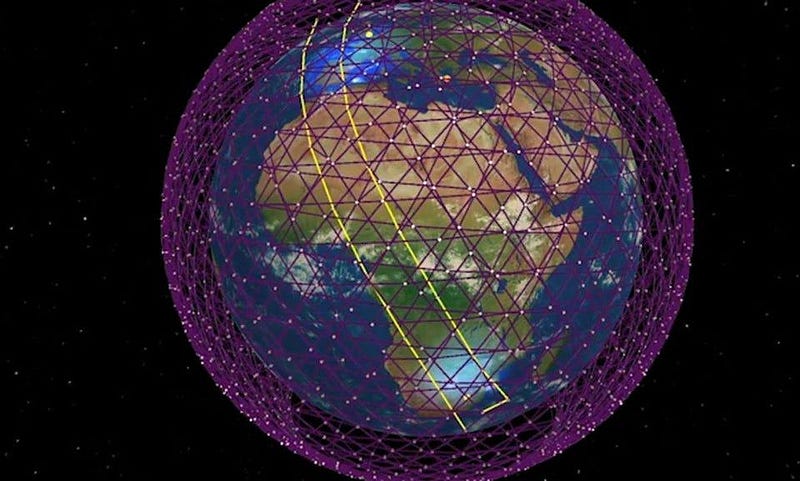
Satellite megaconstellations. Beginning in 2019, however, things began to change dramatically. The first launches of SpaceX’s new Starlink satellites — the first in a coming series of satellite megaconstellations designed to provide modern global internet coverage — came as an immediate jolt to both the astronomy and the civilian communities. The new satellites were:
- bright, brighter than all but a few dozen stars during the initial deployment phase and still visible to the naked eye when in their final orbits,
- numerous, with 60 or so satellites deployed in each launch and a total of 1656 presently orbiting Earth,
- and in trails, so that when you see one, you’re likely to see a string of many following a similar trajectory over the coming minutes.
SpaceX alone is planning a total of 42,000 satellites in low-Earth orbit, and although they have already enacted a number of mitigations, their current satellites are still barely at or just below the threshold of naked-eye visibility under dark skies. When additional planned providers — including OneWeb, Kuiper/Amazon, as well as projects from China, Japan, and other countries — are taken into account, the expectation, according to Dr. Connie Walker of the National Science Foundation’s NOIRLab, more than 100,000 low-Earth orbit satellites seem likely for our near-term future.
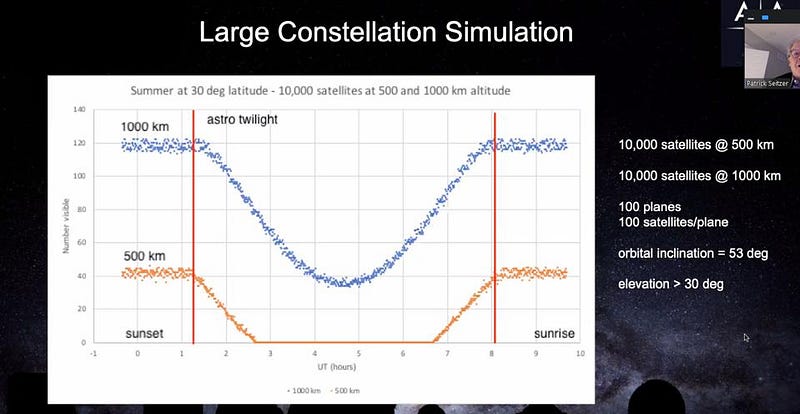
Their impacts on astronomy. Although the goal of providing low-cost, high-speed internet to rural and underserved communities is admirable, the losses are felt by all watchers of the night sky. Casual stargazers, even over the course of an hour, are likely to witness multiple trails of satellites even at present; by 2030, you will be unable to look anywhere at any time without seeing satellites in your averted vision field. Amateur astronomers and astrophotographers are no longer able to image any region of space over the course of the night without interference from many different satellites.
But by far the greatest damage is incurred by professional astronomy. Each satellite that passes within a modern telescope’s field of view will:
- saturate the detector,
- leave a streak across it,
- and its remnant effects will impact the hardware for minutes afterward.
The loss to science cannot yet be measured, but the realistic estimates are dramatic. The upcoming Vera C. Rubin observatory — the largest, fastest, widest-field all-sky survey ever designed — will have satellite trails in an estimated 30–40% of its images. The very things it’s optimized to measure are the ones that will be most greatly impacted by these satellite trails: objects that vary over time, objects that change position over time, transient objects that brighten and/or fainten over time. The identification and tracking of potentially hazardous asteroids may no longer be possible, and we’re almost certain to lose some scientific discoveries that we don’t even know are there to be found.
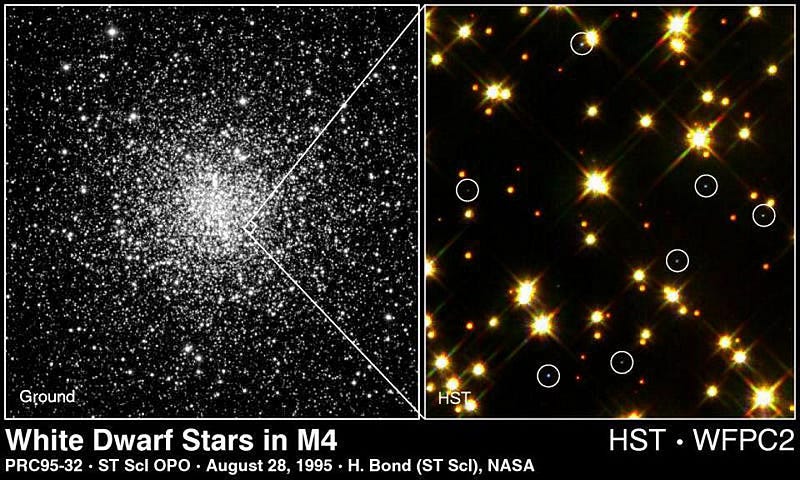
There are four ways humanity can work together to mitigate this problem, but everything depends on our willingness to do so. Right now, there are four different fronts where astronomers are looking for solutions.
Mitigation from regulators. So long as you obey the Outer Space Treaty and don’t damage the functioning of anyone else’s satellites with your own, there are no meaningful international regulations that govern the uses of space. This means that as long as you get approval from your home country, you are free to launch as many satellites with as much optical, radio, or other electromagnetic interference as you like. Additionally, as there are no current limits on the number of satellites in a particular orbit, satellite overpopulation could lead to either a Kessler effect, where a satellite collision leads to a chain reaction of further collisions, or full-blown Kessler syndrome. Approximately ~100,000 satellites at an altitude of ~500 km is anticipated to lead to the latter, which would render low-Earth orbit unusable for generations.
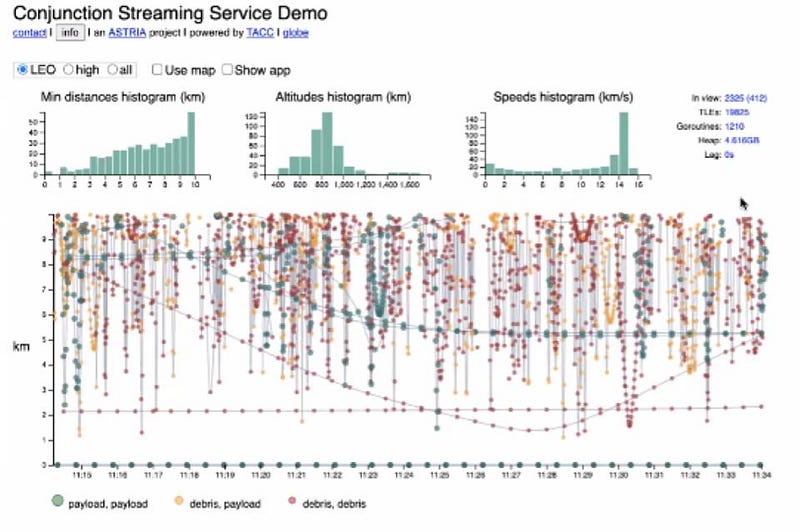
As it stands today, satellites routinely pass within 1 or 2 kilometers of one another, with multiple close passes every minute. As space traffic gets more and more congested, this problem will only worsen.
While requests for injuctions and/or a moritorium on future launches and deployments have been made by companies like Viasat and Dish network, as well as a legal challenge to the FCC’s blanket exemption of space enterprises from the National Environmental Policy Act by Vanderbilt law graduate Ramon Ryan, any set of international regulations will likely take many years to put into place. As numerous astronomers at last month’s European Astronomical Society meeting said, all of Europe’s eyes are on the United States, hoping that we can pave the way for a template to govern the responsible, sustainable uses of space.
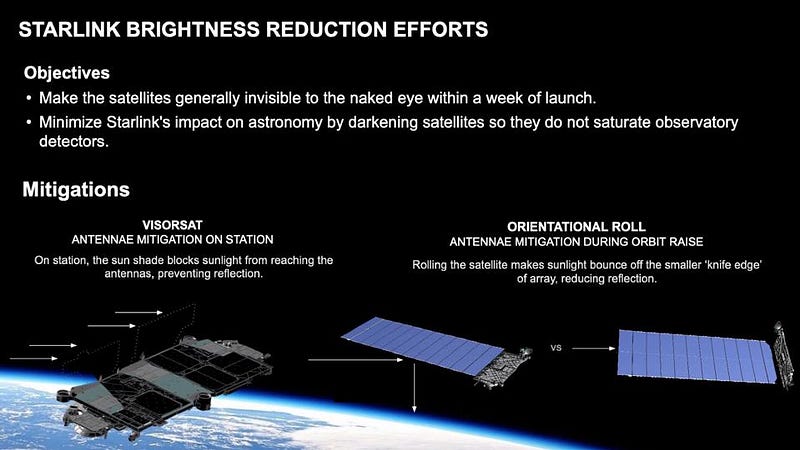
Mitigations from satellite providers. At this point, all mitigations taken by any satellite company are completely voluntary. SpaceX was the first, and they have been very willing to have conversations with astronomers. They have experimented with darkening their satellites, putting visors over them to reduce reflectivity, and have acquiesced to requests to keep their satellites under 600 km in altitude, which will provide astronomers with long windows in every night where observations should be unaffected by their satellites. OneWeb, with the exception of the altitude consideration (their orbits are at ~1500 km in altitude, and as such their satellites will interfere with observations all night), has been similarly happy to meet with astronomers and take recommendations. It’s worth noting, as OneWeb’s Maurizio Vanotti and British astronomer Andy Lawrence pointed out, that placing the OneWeb satellites at ~1500 km orbits rather than ~600 km orbits enables full coverage over their area of interest with hundreds, rather than thousands, of satellites. (For comparison, the higher-latency GPS network, at ~20,000 km altitudes, requires only 24 satellites for full global coverage.)

However, there’s a lot of work left to be done. In particular:
- the companies that are launching these satellites have offered no funding to astronomers for satellite mitigation efforts,
- they have not developed a superior system for providing and standardizing orbital and positional data for these satellites,
- and the data that is currently available needs to be approximately 10 times its current precision to be helpful to astronomers.
Despite recommendations from the SATCON1 workshop that the number of satellites be kept to a minimum, that they all be kept to orbits under 600 kilometers, and that they be darkened significantly below their current brightnesses, we still appear to be looking at the growth of satellite megaconstellations to over 100,000 total satellites over the next decade, none of which have been demonstrated to meet the brightness recommendations and many of which plan on being flown at orbits of ~1000 km or higher.

Mitigations from software. Ideally, you could imagine a scenario where these satellite trails could be dealt with through a smart enough software package: one capable of digitally removing the satellite streaks while leaving the remaining portions of the images intact, minimizing the science losses. Every time we attempt to remove a streak, however, such as by time-averaging over the data or removing the streaked portion of the images, we lose valuable scientific information. These techniques, when applied to the scientific field of time-domain astronomy — which is necessary for the detection of transients, fast variations, and rapidly moving objects — is like chemotherapy: it might kill off the affliction, but the treatment severely damages the very thing it’s trying to save. According to Dr. Moriba Jah,
“Signal removal is something we should stop doing. It’s not going to get better. Instead, we should be good at detecting different behaviors in any given data cube and neglect the ones we don’t care about. Stars, cosmic rays, and anthropogenic objects all behave in particular ways, so if we can categorize the data statistically, rather than removing signals, we might be able to extract the signals we’re interested in.”
This is not an easy task in any way, and all observational efforts directed towards satellite mitigation takes time and money away from science. Without a source of funding for this necessary mitigation work, the scientific endeavor suffers as a whole.
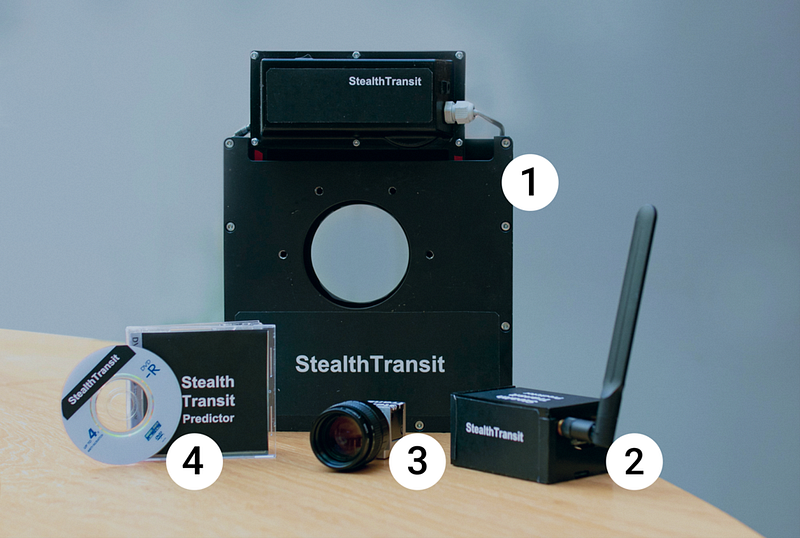
Mitigations from hardware. A superior alternative for many applications — from astrophotography to narrow-field ground-based and even space-based telescopes — would be the ability to “actively shutter” your telescope when a satellite passes through your field-of-view. Simply by:
- knowing exactly when a satellite will enter and exit your telescope’s field-of-view,
- rapidly closing the shutter prior to entry,
- rapidly reopening the shutter after exit,
- and taking data, continuously, during all times that the shutter is open,
the “streak” effects and hardware saturation problems could be eliminated entirely, while cutting the timescales over which the scientifically usable data is afflicted from minutes down to seconds.
While many view this as a technological solution that’s likely to be far off in the future, one company — StealthTransit, led by Vlad Pashkovsky — has come up with an implementation of this idea that doesn’t rely on a foreknowledge of satellite positions and motions. Instead, what their system does is scan a larger area of the sky than the telescope images for streaking satellites, and identifies when one is about to enter the telescope’s main field-of-view. By actively and responsively shuttering and un-shuttering the telescope, the effects of satellite trails can be eliminated completely while otherwise minimizing the net data loss.
In many ways, outer space is very much still the wild, wild west in its lawlessness. Companies, so long as they meet with the approval of (sometimes extremely lax) regulators in their home country, can launch as many satellites as they’re approved for with whatever orbital parameters they gain approval for, with no restrictions on their optical brightnesses. Astronomers, at present, can only make recommendations to satellite providers, while no organization has the power to enforce those recommendations. Meanwhile, no additional funds are being provided to help with mitigation efforts, and no international regulations are in the process of being put into place.
Despite the widespread sentiment that the night sky is a natural resource that belongs to no person, corporation, or nation, the actions of a few companies and individuals are dramatically changing the skies for the foreseeable future for all 7+ billion of us here on Earth. As Ian Ayres and John Braithwaite wrote in Responsive Regulation back in 1992,
“We have seen that corporations may be more capable than the government of regulating their business activities. But if they are more capable, they are not necessarily more willing to regulate effectively. This is the fundamental weakness of voluntary self-regulation. A voluntary program will stop many violations that cost the company money and others that are cost neutral; it will even halt some violations that benefit the company financially in the short term, for the sake of the long-term benefit… Recommendations that involve consequences beyond the cost neutral or short term, however, commonly will be ignored.”
Unless we reckon with these issues responsibly, sustainably, and — most importantly — quickly, we could be dealing with the fallout from these rapidly deployed satellite megaconstellations for generations, and perhaps even centuries, to come.
Starts With A Bang is written by Ethan Siegel, Ph.D., author of Beyond The Galaxy, and Treknology: The Science of Star Trek from Tricorders to Warp Drive.





